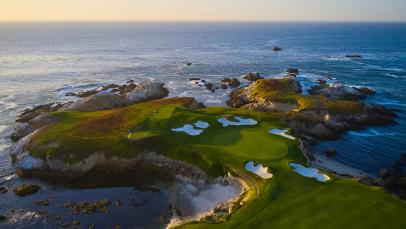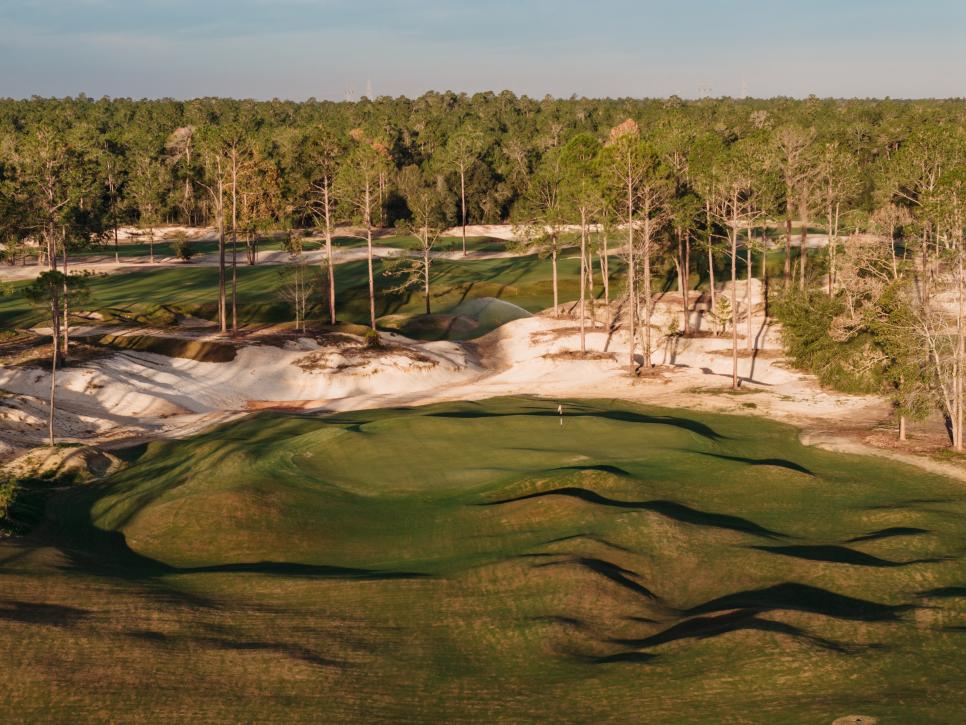Our expert’s review of Cabot Citrus Farms reveals why the Karoo course is golf’s most unique new design – Australian Golf Digest

- by Admin
- August 20, 2024

At first impression, the new Karoo Course at Cabot Citrus Farms in Florida strikes chords of both familiarity and otherness. With its washes of sand, nibbled-on bunker edges and burbling swaths of turf it is of the moment in golf architecture, a clear branch off the tree of Sand Hills and Bandon Dunes, nurtured in the sun of Sand Valley, Streamsong and Ohoopee with a distant genetic chromosome from Pinehurst. It is also alien, a torn and riven world of vertigo-inducing obfuscation plied with hidden pathways, orphaned pines, trap doors and scabrous, sulfur-smoking pits.
The phantasmic Karoo landscape comes from the imagination of architect Kyle Franz, who designed it over the top of the Pine Barrens course at the former World Woods Golf Club near Brooksville, Fla., an hour north of Tampa. The Cabot Collection, the Canada-based luxury resort developer behind Cabot Cape Breton, Cabot Saint Lucia and other international golf destinations, acquired the struggling World Woods facility in 2022 and rebranded it Cabot Citrus Farms. A second course, the Roost, on the site of the former Rolling Oaks course (also designed by Franz along with architect Mike Nuzzo and Ran Morrissett), opens for preview play this fall, accompanied by a new 10-hole regulation course (The Squeeze) and 11-hole short course (The Wedge), both designed by Nuzzo. All courses will be available for resort play, with accommodations in two- and four-bedroom cottages.
Jeff Marsh Public Cabot Citrus Farms: Karoo Brooksville, FL, United States
When arriving at Cabot Citrus Farms you’ll understand why Ben Cowan-Dewar sought this property for decades. A prehistoric ridge in Brookville, Fla., created rolling topography on sandy soil—a golf developer’s dream. In the early 1990s, World Woods opened with two acclaimed public courses and what was once the world’s largest driving range that hosted Tiger Woods commercial shoots. But playing conditions had deteriorated at World Woods. Its Pine Barrens course, once the 75th-best course in Golf Digest’s ranking of America’s 100 Greatest Courses, quickly fell off that list in 2013. Cowan-Dewar inquired about the property with the previous owner, Japanese businessman Yukihisa Inoue, in 2014 and 2016, to no avail. Others also tried to buy it. Finally, as COVID-19 restricted travel, Cowan-Dewar chatted with Inoue through translators over Zoom and negotiated to purchase the property in 2021—giving his burgeoning Cabot resort and real estate empire its first U.S. offering. That decades-long courtship has now paid off with Cabot Citrus Farms’ Karoo course, which opened this winter. —Stephen Hennessey For a complete review of the newly opened Karoo course, click here.
View Course
We urge you to click through to each individual course page for bonus photography, drone footage and reviews from our course panelists. Plus, you can now leave your own ratings on the courses you’ve played … to make your case for a destination we might’ve missed on this list, or why your favorite should be ranked higher.
BACKGROUND 
Second shots chose between lower and upper routs at Karoo’s wild par-5 14th.
While the entire campus of Cabot Citrus Farms has been revamped and expanded, it’s the Karoo, the centerpiece attraction opening in full this fall, that demands the most study and scrutiny. To the uninitiated it will be perhaps the most flamboyant and aggressively designed course in memory with extreme green contour and prodigious fairways divided by ridges and sand chasms that set up heroic tee shots and alternative risk/reward lines of play.
For the initiated—those who knew World Woods—it is a shocking transmogrification, a near total strip-down of a once great course. When Pine Barrens, situated on a broad dune ridge, opened in 1994 it was hailed as an every-person’s Pine Valley, open to the public with fairways outlined by deep sandy pockets and rugged waste bunkers, each hole a unique entity ensconced in pines. The Tom Fazio design managed to be rugged, elegant and intimate, the fairways tottering above sand caverns and tumbling into pitched greens. Though better known for building high budget private courses, Pine Barrens was among Fazio’s greatest efforts and rose to No. 75 on America’s 100 Greatest Courses, all the more important because anyone could play it.
The golf economy was not kind to World Woods and the courses suffered a steady decline. The property was in need of work, and Cabot thankfully stepped in to revive the complex, bringing along Franz to inject Pine Barrens with fresh energy. For Franz, fresh energy meant a fresh start and he, too, looked to Pine Valley for inspiration, though farther back in time to when the course first opened, when the namesake trees were mostly saplings and horizons were visible across the New Jersey sand barrens.
The direction inspired him to remove a majority of trees from the Karoo site, a decision that might enhance the health of the turf but also erases the natural sensuousness that made journeys through Pine Barrens’ feel exotic. Karoo’s departure is stark, the naked landscape awash in waves of riptide ground movements and exposed sand bobbing in all directions. The holes occupy the same corridors with the same green sites, though everything is expanded and redesigned bigger and more obviously sculpted. The parallel par 3s at three and 16 in the northwest corner have reversed direction, the former now a 292-yard one-shotter to a disorienting, titanic green set in a basin with too many levels and kick slopes to count. The second and 17th holes, side-by-side par 4s, have also flip-flopped place and direction.
.jpg.rend.hgtvcom.966.725.suffix/1721399996549.jpeg)
Matt Majka
More From Golf Digest  Golf Digest Logo America’s 100 Greatest Golf Holes VERDICT
Golf Digest Logo America’s 100 Greatest Golf Holes VERDICT
Karoo is Franz’s coming out party. He cut his teeth working projects primarily for Tom Doak and Gil Hanse before moving to Pinehurst where he executed highly regarded remodels of Pine Needles, Mid Pines and Southern Pines. Cabot Citrus Farms is his first opportunity to construct an entire course independently, even if he inherited the routing. Like many newly untethered artists he’s packed the design with a wellspring of ideas, about alternate lines of play, about ground volatility, about tactical golf.
It’s reasonable to debate the effectiveness—or necessity—of stripping and flipping the entire property. What isn’t debatable is that Karoo is a high concept creation that will become more cohesive as it matures. Cabot founder Ben Cowan-Dewar and Franz both understand that their clientele, who view the game through the lens of high-end destination resort courses, don’t travel long distances to play ordinary golf. And they won’t find that here.
They will find prodigious greens with elevated sections vaulted above others and fairways split by raw deserts that make players make choices, even if the benefit of one choice over another it isn’t always clear (the par-4 18th has three fingers of fairway). There are also blind shots, a double green for one and six rivaling the size of those at St. Andrews, a Dada-esque push-up punchbowl green at 13 that sprouts magically out of its flat surrounds, and polarizing holes presented without apology like the aforementioned third and the long, uphill par-4 12th with a green perched behind a fortress of sand.

The pop-up punchbowl green at 13 would make Marcel Duchamp smile.
But these idiosyncrasies are why people from across the continent will travel to Cabot Citrus Farms, and the strangeness will be an asset that helps the golf stand apart in a competitive Florida resort market that includes Streamsong, TPC Sawgrass and others. Cabot is making a bet on sand, on Franz, and on the desire of guests to explore an unusual walking-only course that challenges their driver, their wit and their short games—and even their sense of humor—in unique ways. The bet here is on Cabot. They’ve yet to lose one.
More from Golf Digest  Course Reviews The best courses you can play in Florida
Course Reviews The best courses you can play in Florida
• • •
Explore Golf Digest’s new Course Reviews section where you can submit a star rating and evaluation on all the courses you’ve played. We’ve collected tens of thousands of reviews from our course-ranking panelists to deliver a premium experience, which includes course rankings, experts’ opinions, bonus course photography, videos and much more. Check it out here!
This article was originally published on golfdigest.com
The Latest News
-
January 10, 2025‘They can say what they want’: Smith excited with Test captaincy return
-
January 10, 2025Eye-watering record cash prize Australian Open winner will win
-
January 10, 2025Nervous 9999s: Steve Smith rues milestone miss as he backs teenage tyro to be a hit
-
January 10, 2025UK seaside town leaves Australian tourist completely baffled
-
January 10, 2025Kyrgios steps up Australian Open preparation in a positive sign





